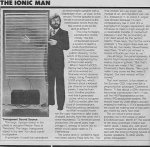Interesting new technology if you haven't seen it... from Wired:
http://www.wired.co.uk/news/archive/2013-09/02/gel-speakers said:Material scientists at Harvard University have developed a translucent speaker made out of a thin sheet of rubber squished between two membranes of saltwater gel.
By running a high voltage ionic signal across the surfaces, the rubber can be made to rapidly contract and vibrate, producing sounds that span the audio spectrum between 20 hertz and 20 kilohertz. The technology was used to play Edvard Grieg's Morgenstimmung in a demonstration video embedded in this post.
This is an important proof of concept for ionic conductors, since speakers require both a high voltage and high-speed vibrations -- two criteria that are important for a wide range of applications, but have been ruled out of previous tests of ionic materials. This is because high voltages tend to set of electrochemical reactions, which cause damage to the materials. Moreover, ions -- being larger and heavier than electrons -- have generally moved very slowly through circuits. The Harvard team has overcome these challenges with the combination of the polyacrylamide gel swollen with salt water and the rubber.
This demonstration could pave the way for developing ionic conductors to replace some electronic systems. A key benefit to using ionic conductors is the fact that they can be stretched many times to cover a large surface area without affecting their resistivity -- stretchable electronic devices tend to demonstrate an increase in resistivity when stretched. Ionic conductors can also be transparent and the gels used are biocompatible so could be easily introduced to the body -- opening up the possibility of having an artificial muscle that could contract on demand.
Co-lead author Christoph Keplinger, a postdoctoral fellow at Harvard School of Engineering and Applied Sciences (SEAS), who worked on the project, said: "The big vision is soft machines. Engineered ionic systems can achieve a lot of functions that our body has: they can sense, they can conduct a signal, and they can actuate movement. We're really approaching the type of soft machine that biology has to offer."
Jeong-Yun Sun, a postdoctoral fellow at SEAS, added that it might seem counter-intuitive that ionic conductors could be used in a system that needs very fast actuation, as speakers generally do. "Yet by exploiting the rubber layer as an insulator, we're able to control the voltage at the interfaces where the gel connects to the electrodes, so we don't have to worry about unwanted chemical reactions. The input signal is an alternating current (AC), and we use the rubber sheet as a capacitor, which blocks the flow of charge carriers through the circuit. As a result, we don't have to continuously move the ions in one direction, which would be slow; we simply redistribute them, which we can do thousands of times per second."
The system doesn't need a lot of power and could be used as a soft transparent layer that deforms in response to electrical stimuli and even create active noise cancellation on windows so that rooms could be completely silent inside. Similarly, the team believes that the technology could be used to develop a pair of glasses that shift between modes: wide angle, reading or telephoto, based on voice commands.
Harvard plans to commercialise the technology, working with companies involved in tablet computing, smartphones, wearable electronics, adaptive optics and consumer audio devices.
The next step is to experiment with a wider range of ionically conductive materials. You can read the full study published in Science.


